SEASON AND VARIETY
 Season
Season
 Varieties
Varieties
Season
TAMILNADU
Wetland
-
The Best time for planting in Wetland are Febraury to April and April to Mayan, Nendran and Robusta
-
Poovan, Rasthalli, Monthan, Karpooravalli,and Ney Poovan are the best varieties grown well at the time of Febraury to April.
-
Nendran and Robusta are the best varieties grown well at the time of April to May.
Garden lands
-
The best time for planting in Garden Lands are January to Febraury and November to December
-
Robusta, Nendran,D.Cavendish are the best varieties grown well in Garden lands.
Padugai lands
-
The best time for planting in Padugai lands are January to Febraury and August to September.
Hill banana
-
The best time for planting in Hill Banana are April to May and June to August.
-
Namaran,Ladan,Manoranjitham Sirumalai and Virupakshi are the best varieties grown well in Hill Banana.
Tissue banana
-
The best time for planting in Tissue banana are Throughout the year (except when temperature is too low or too high).
-
Grand naine is the best variety grown well in Tissue Banana.
KERALA
Irrigated crop
-
The best time for planting in Irrigated crop is August to September.
-
Nendran (Clones)like Nedunendran, Zanzibar,Chengalikodan and Table varieties like Monsmarie, Robusta, Giant Governor, Dwarf Cavendish, Chenkadali, Poovan, Palayankodan, Njalipoovan, Amritsagar, Grosmichael, Karpooravally, Poomkalli, Koompillakannan, Chinali Dudhsagar), BRS-1 and BRS-2 are the best varieties grown well in Irrigated crop.
Intercropping in coconut
-
The best time for planting in Intercropping in Coconut is April to May and August to September.
-
Njalipoovan, Robusta, BRS-1 and BRS-2. Dudhsaga(highly resistant to major pests and diseases) are the varieties grown well. The variety Boldles Altafort is recommended for high range region (ad hoc).
Rainfed Crop
-
The best time for planting in Rain fed crop is April to May.
-
Culinary varieties like Monthan, Batheesa, Kanchekela, Nendrapadathy are the best varieties grown well in Rain fed crop
KARNATAKA
The best time for planting in karnataka is by the end of the june.
Peak season in karnataka are
-
April-June
-
September-March
Bontha and Mauritius and for Poovan the best time is November to January beacause it has a no longer duration
Varieties
Hybrids:
CO 1
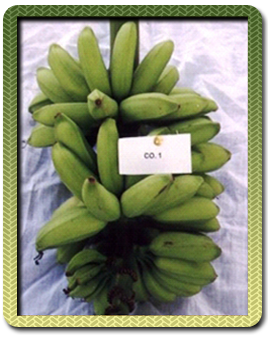 |
-
It is a hybrid clone released by Tamil Nadu Agricultural University, Coimbatore involving three parents - Ladan, Kadali and Musa balbisiana.
-
It is akin to hill banana Virupakshi in flavour and taste and suitable for growing in the plains and hills upto 1200 meters elevation.
-
It yields about 22 t/ha.
-
The crop duration is 14 months.
Udhayam
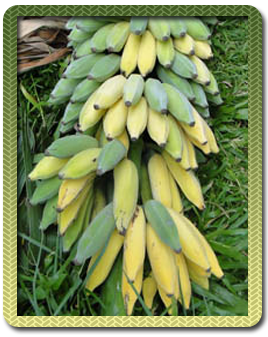 |
Special Features
-
This hybrid is developed by single plant selection from Pisang Awak (AAB) sub
group at National research Centre for banana , Trichi. -
Plant is hardy, tall, robust, bunch weight varies from 30-35 kg.
-
Hands are well spaced with cylindrical shape which facliattes packing, loading and transport with minimum damage.
-
Fruit quality is medium, sugar acid blend is good with maximum yellow life (7days).
Remarks
-
It is ideal cultivar for wind prone areas.
-
Immune to Banana Bunchy Top viral diseases, salt tolerance and normal bunch mass even under marginal condition.
-
Highly susceptible to Fusarium wilt disease.
BRS1
Special Features
-
It is triploid hybrid of banana by crossing Agniswar x Pisang Lilin developed at Banana Research Station, Kannara, Kerala Agricultural University.
-
It is a medium tall plant, supporting 14-16 kg bunch without propping.
-
Elongated fruits turn attractive golden yellow on ripening.
-
Slightly acid fruits.
Remarks
-
It has a remarkable early rationing ability completing four crops in three years.
-
It is a promising hybrid owing to short cropping cycle resistance to leaf spot,Fusarium wilt and burrowing nematode.
BRS 2
Special Features
-
It is a hybrid of Vannan x Pisang Lilin developed at Kannara Banana research station, Kerala Agricultural University.
-
It is medium stature plant.
-
Average weight of bunch ranges from 15-20 kg with short, stout, dark green Poovan like fruits which are arranged compactly.
-
Fruits are slightly acidic with pleasant sweet-sour aroma.
Remarks
-
Tolerance to leaf spot diseases and nematodes.
FHIA-0 1
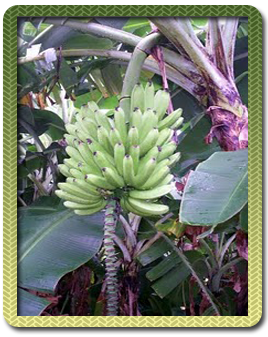 |
Special Features
-
It is also called as Gold finger and high yielding hybrids which replace Pachananda and Bluggoe varieties.
-
It is a Pome hybrid developed from the combination of SH-3142 x Dwarf Prata in Honduras.
It bears heavy bunches (20-25 kg) without propping in 14-15 months. -
Fruits have sub acidic or apple flavor.
-
It is highly resistant to black Sigatoka, Fusarium wilt and apparently resistant to burrowing nematode.
-
Fruits have a good shelf life without premature detaching.
Remarks
-
Fruits are used as dual purpose.
-
It has superior growth, yield and quality pararmeters than Pachanadan.
-
Its tolerance to sodicity has been a boon to saline sodic soils of India.
Saba
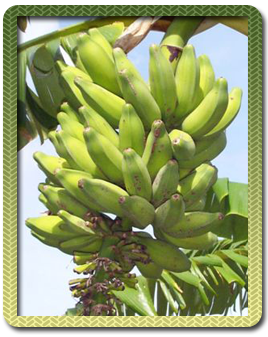 |
-
It is an introduction from Phillipines and it is found promising under in saline sodic soils.
-
It could perform well withpout any yield reduction in sodic soils with PH 8.5-8.75.
-
Plant with huge pseudostem and grows to a height of 16-20 feet.
-
It is a sturdy plant and somewhat cold tolerant.
-
The fruit is large and angular even when ripe. It has a white pulp which is sweet when ripe although very starchy.
-
This cultivar is used for cooking.
Grand Naine
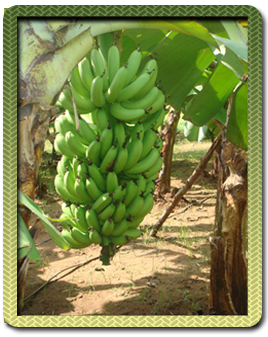 |
Special Features
-
Each bunch will be having 10 to 12 hands with 175 to 225 fruits.
-
The fruits of Grand Naine Banana variety are delicious to eat and keeping quality of the fruit is good.
-
High yield (Avg. 30 kg per plant)
-
Long cylindrical fruits with less curvature.
-
Good keeping quality.
-
Attractive yellowish green colour at maturity.
-
Internationally acceptable both as fresh fruit and in processed form.
-
Pulp to peel ratio is more and highly suitable for processing.
Tamil Nadu
Culinary Varieties
Monthan
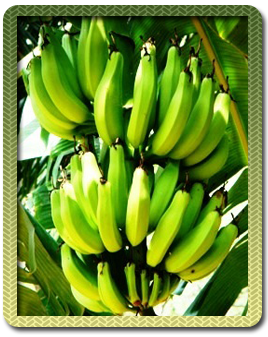 |
Special Features
-
Exclusive culinary variety, widely cultivated for processing.
-
Plant hardy, somewhat drought resistant.
-
Suitable for growing as intercrop in .coconut gardens.
-
Suitable for cultivation for leaf production in Trichy and Tanjore districts of Tamil Nadu.
-
Bunch medium, 20 to 25 kgs, 60 fruits.
-
Fruits large, irregularly five sided, ridges prominent, slightly curved, broad at base tapering towards apex, rominent knob-like beak, long pedicel.
-
Peel - thick, tough, peels with difficulty, dark green turning straw yellow.
-
Pulp - firm, cream coloured, core conspicuous, medium taste.
-
Fairly tolerant to nematodes and leaf spot and rhizome rot diseases.
-
Crop duration 12 to 14 months.
-
It is highly susceptible to Fusarium wilt disease
Ney mannan
 |
Special Features
-
Vayal vazhai of Tanjore, Mey Vannan of Kongad, Naattu vazhai of Pannaikkadu.
Plant robust, medium height. -
Bunch large, compact, 18 kg, upto 10 hands.
-
Fruits – small to medium, plump at base, tapering at apex, irregularly 5 sided, thick beak.
-
Peel - thick, tough, peels easily, dark green turning orange yellow when ripe.
-
Pulp - firm, white, not very sweet.
-
Crop duration 12 months.
Desert Varieties
Dwarf Cavendish
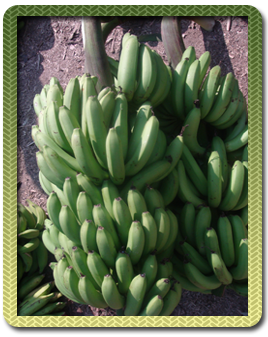 |
Special Features
-
Introduced variety, important for international trade and high density planting.
Plant dwarf. -
Bunch weight 20 - 25kg, 12 hands, 150 or more fruits.
-
Fruits - large, long curved, peel - thick, green, greenish colour retained to some extent even after ripening.
-
Pulp - soft, sweet, juicy, delightful aroma.
Chakkerakeli
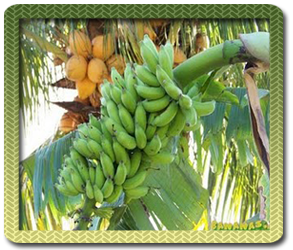 |
Special Features
-
Choice variety grown in Tamil Nadu in Kulitalai & Thanjavur regions.
Exceedingly sweet but poor fruit keeping quality. -
Plant - slender, medium size, petiole borders open & conspicuously red.
-
Crop duration – 13 months.
-
Bunches with 8 hands of 12 fingers each, 10 kg weight.
-
Fruits - medium size, cylindrical, somewhat 5 cornered non prominent ridges, pedicel long and tough; thin skin which peels off easily, pulp - yellowish, juicy, tasty.
Robusta
 |
Special Features
-
Semi dwarf mutant of the tall Lacatan.
-
Plant – medium sized, stem dark purple with greenish tinge.
-
Bunch – pendulous, 7-9 hands per bunch, 12-15 fingers per hand. Average 100
fruits per bunch, 25-30 kg. -
Fruits - large, skin medium thick, ripe fruits drop off easily, fruits - green to dull yellow, pulp - sweet, juicy, agreeable flower, better keeping quality than Dwarf Cavendish.
Susceptible to leaf spot, corm weevil, rhizome rot and mosaic diseases.
Crop duration - 12 to 14 months.
Rasthali
 |
Special Features
-
Delicious variety grown mostly in Erode and Tiruchirapally districts.
-
Plant tall (4 to 4.5m height), stem - yellowish green with brownish blotches, reddish margins of petiole and leaf sheath.
-
Bunch - 15 to 20kg, 8 to16 hands, 60 to 80 fruits.
-
Fruits - medium sized, cylindrical to spindle shaped, weak pedicel, skin - thin, peels easily, ivory yellow, flesh - firm, sweet, pleasant aroma.
-
Demerits are its susceptibility to panama wilt, formation of hard lump in pulp and easy dropping of fruits from the bunch.
-
Crop duration - 14 to15 months.
Ariyanka Rasthali
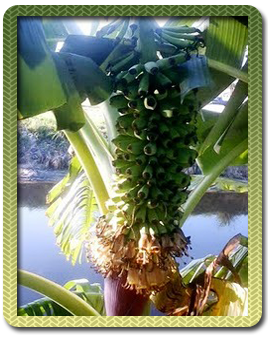 |
Special Features
-
It is also called as Poovilla Konnai in Pollachi areas and Ayiranka Poovan in Tirchur.
-
An unstable bud variant of Rasthali.
-
Varies from Rasthali only in that there are no male flowers so that the whole axis is covered with fruits.
-
The fruits of the first 5 to 6 hands are same as those of Rasthali, while the rest differ only in size.
-
Bunch 500 fruits, 25 kg.
-
Crop duration 15 months.
Karpooravalli
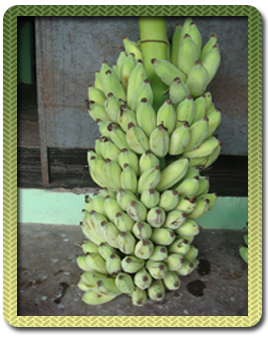 |
Special Features
-
It is a popular variety grown for table purpose in medium rich soils.
-
Its commercial cultivation is spread over Central and Southrn districts of Tamil Nadu.
-
It is also sweetest among Indian bananas.
-
Plant - stout, vigorous and tall with large leaves, stem light green with purplish tinge.
-
Bunch 8-9 compact hands, 13-14 fingers per hand, 100 to 120 fruits per bunch.
-
Fruits - medium size, persistent on pedicel even after ripening, skin - medium thick, yellow with ashy coating.
-
Pulp - sweet and juicy, firm, pleasant flavour.
-
This variety thrives even in alkaline soils.
-
It can also be raised for leaf production
-
It is fairly tolerant to corm weevil
-
Crop duration 12-14 months.
Virupakshi
 |
Special Features
-
Premium variety grown in the lower Palani hills of Kodaikanal range in Tamil Nadu.
-
Perennial banana of high quality, grown as rainfed crop either as mixed with coffee or pure plantation.
-
Plants - tall, 4.5 to 5.0m height
-
Poor yielder, with small bunches 8 -12 kg, 7 - 8 hands of 10 -12 fruits each,80 - 90 fruits per bunch.
-
Fruits - small to medium, prominently ridged, skin - thick, leathery, greenish yellow and turning black when over ripe, peels easily.
-
Pulp - white or pale yellow, dry, sweet with delightful flavour.
-
Very good keeping quality.
-
Fruits strongly attached to pedicel even on ripening.
-
Crop duration is 15-18 months.
-
It has the characteristic flavor only when they are cultivated in higher elevation.
Perennial system aggravates Banana Bunchy Top Virus (BBTV).
Sirumalai
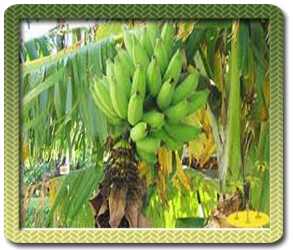 |
Special Features
-
The Sirumalai type grown in the Sirumalai Hills is considered to be an ecotype of Virupakshi.
-
The only difference is that in the Sirumalai type, pulp is not as dry, but is juicier to sweeter and richer in flower.
-
Fruit attachment to the pedicel is not as strong as in Virupakshi.
-
Crop duration 14 months.
Poovan
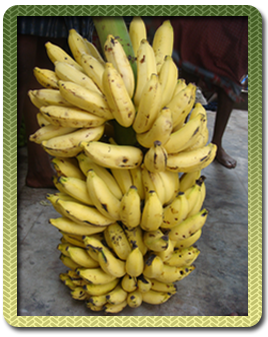 |
Special Features
-
Important commercial variety of Tamil Nadu produced year round in largequantities.
Plant tall and vigorous. -
Bunch - large, 25 kgs, 12 hands, upto 18 fingers, 200 or more fruits.
-
Fruits - medium size, cylindrical, pronounced nipple, skin - thin, bright yellow, peels off easily
Pulp - soft, juicy, yellow, acid-sweet taste, good flavour. -
Crop duration 11-14 months.
-
It is highly susceptible to Banana Mosaic Virus(BBMV) and Banana Streak Virus (BSV) which causes reduction in yield.
Red banana
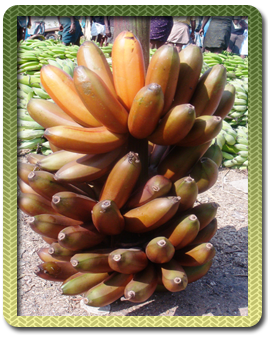 |
Special Features
-
It is the most relished and highly prized variety.
-
Its commercial cultivation is prominent in Kanyakumari and Tirunelveli districts of Tamil Nadu
Lesser grown variety, grows upto elevation of 1300 m above msl. -
Plant tall, robust, pseudostem petiole characteristic deep red colour, free suckering.
-
Bunch 20-25 kg, over 100 fruits under good management practices.
-
Fruits - large, spindle shaped, short pedicel, blunt tip, peel - thick, leathery, red colour, peels easily.
-
Pulp - orange yellow, juicy,sweet, moderate but distinct flavour.
-
Fairly tolerant to wilt disease.
Crop duration 18 months.
It is highly susceptible to bunchy top, fusarium wilt and nematodes.
Sanna Chenkadalai
 |
-
Hardy variety.
-
Plant resembles that of red banana with red coloured pseudostem, petiole and
midrib.
-
Bunch medium sized.
-
Fruits - small, slender, pronounced tip, peel red colour.
-
Pulp - light orange yellow.
-
Performs well even in complete shade suited for planting in coconut grooves.
-
Tolerant to leaf spot.
-
Crop duration 12 months.
Matti
 |
Special Features
-
Common variety of Southern districts of Tamil Nadu.
-
Plants less hardy.
-
Bunch - excellent grade, upto 30 kg, 18 hands
-
Fruits - small, long, pronounced tip.
-
Pulp good taste
-
Useful variety for breeding as it is male and female fertile.
-
Crop duration 12 months.
Namarai
Special Features
-
Grown commonly in Kanyakumari district.
-
Not hardy
-
Good male parent for breeding purposes
-
Fruits small with good taste
-
Crop duration 12 months.
Pachanadan
 |
Special Features
-
It is a popular variety in Tamil Nadu especially for its cooling effects in hot tracts in summer.
-
It is well suited as an intercrop in coconut/arecanut garden.
-
Duration is about 15 months.
-
The bunch weight ranges from 12-15 kg (after 11-12 months).
-
It is used both when green and ripe.
-
Pachanadan could be used in the Nendran plantations for gap filling as it comes up for harvest along with Nendran.
-
It is tolerant to leaf spot and Banana Bunchy Top Virus(BBTV) diseases, but susceptible to wilt disease.
Lacatan
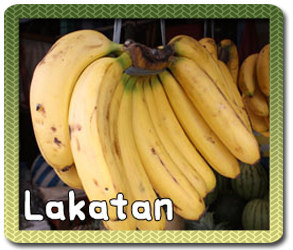 |
Special Features
-
The Lacatan cultivar is the typical bananas we found in the market for dessert.
-
It has an attractive golden yellow color when ripe.
-
The skin can be removed easily with some rags sticking to the pulp, revealing a light orange to orange pulp.
-
The cultivar has a very aromatic and excellent flavor.
-
Fruit size ranges from 10 to 20 cm in length.
Dual Purpose varieties
Nendran
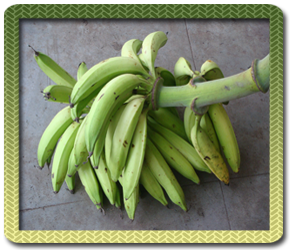 |
Special Features
-
Largely grown in Trichirapalli and Coimbatore districts.
-
Important variety for processing.
-
Fruits eaten ripe and raw, or used as vegetable in the mature unripe condition.
-
Plant has distinct pink colouration in pseudostem.
-
Bunch not compact, 12-15 kgs, 4-6 hands, 3 prominent ridges, distinct nipple.
-
Fruits - large, long, thick, peel - thick and leathery, golden yellow, peels with difficulty.
-
Pulp - firm, flesh coloured, core fairly conspicuous mild flavour, medium sweet.
-
Good keeping quality.
-
Not suitable for ratoon crop.
-
Crop duration 11-12 months.
Sakkai
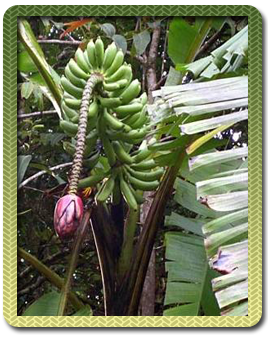 |
Special Features
-
It is commercially cultivated under low input conditions owing to its tolerance to drought, salt and nematodes.
-
It is a dual purpose variety.
-
Commercial plantations is seen in Madurai,Tirunelveli and Kanyakumari districts of Tamil Nadu.
-
It is a medium plant which takes 12-14 months to come to harvest.
-
Bunch weights about 15-18 kg.
-
Fruits are short, stout and have no knob.
Karnataka
Culinary Varieties
Monthan/ Kari bale
 |
Special Features
-
It is a widely distributed variety in all banana growing areas of Karnataka.
-
It is a fairly tall and robust plant weighing a bunch of 18-20 kg.
-
Fruits arebold, stocky,knobbed and pale green in colour.
-
Apart from its culinary purpose, pith is highly relished vegetable with lot of medicinal properties.
-
Male flowers without stamens are also used as a popular dish.
-
It is highly susceptible to banana bract mosaic virus and Fusarium wilt disease.
Bontha
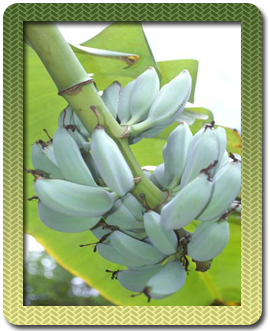 |
Special Features
-
Bunch has 5-6 hands. This is the foremost cooking variety of the state.
-
The fruits are short slightly curved with prominent ridges and blunt apex.
-
The rind is thick and green with whitish pulp.
-
The male bud is also used for culinary purpose, Suitable for entire state.
Desert Varieties
Dwarf Cavendish
 |
Special Features
-
It is a popular commercial cultivar grown extensively for table and processing purpose in Karnataka.
-
The plant stature is Dwarf making it less prone to wind damage.
-
The bunch size, the fruit length and size is quite good though the keeping quality is rather poor.
-
The average bunch weight with 6-7 hands and with about 13 fruits per hand is about 15 - 25 kg. The thick rind of the fruits retains to some extent the greenish colour even when the fruits are ripe.
-
Performs well under light soils with high inputs.
-
In combination with high-density planting and drip irrigation, Dwarf Cavendish is becoming a highly successful cultivar.
-
It is highly susceptible to Sigatoka leaf spot disease in humid tropics restricting its commercial cultivation.
Robusta
 |
Special Features
-
It is a semi-tall variety, grown mostly in Tamil Nadu and some parts of Karnataka for table purpose.
-
It is a high yielding and produces bunch of large size with well developed fruits.
-
Dark green fruits turn bright yellow upon ripening depending on ripening conditions.
-
Fruit is very sweet with a good aroma.
-
Bunch weighs about 25-30 kg. Requires propping.
-
Fruit has a poor keeping quality leading to a quick breakdown of pulp after ripening, hence not suited for long distance transportation.
-
Robusta is highly susceptible to Sigatoka leaf spot disease in humid tropics.
Amruthapani (Rasthali)
 |
Special Features
-
It is a medium tall variety commercially grown in Karnataka.
-
Its unique fruit quality has made Rasthali popular and a highly prized cultivar for table purpose.
-
Fruits are yellowish green throughout their development, but turn pale yellow to golden yellow after ripening.
-
Fruit is very tasty with a good aroma.
-
Longer crop duration, severe susceptibility to Fusarium wilt, requirement of bunch cover to protect fruits from sun cracking and formation of hard lumps in fruits make crop production more expensive.
Poovan
 |
Special Features
-
It is a leading commercial cultivar grown throughout the country with location specific ecotypes.
-
It is generally cultivated as a perennial crop.
-
Fruit is slightly acidic, firm and has typical sour-sweet aroma. Fruits turn to attractive golden yellow on ripening.
-
Medium sized bunch, closely packed fruits, good keeping quality and resistant to fruit cracking is its plus points.
-
But it is highly susceptible to Banana Bract Mosaic Viral (BBMV) disease and Banana Streak Virus, (BSV), which cause considerable reduction in yield.
Elakki Bale
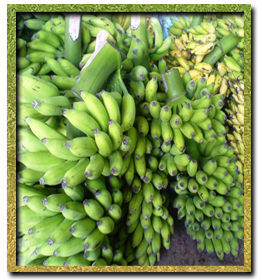 |
Special Features
-
It is generally called as Ney Poovan.
-
Ney Poovan is the choicest diploid cultivar, which is under commercial mono cultivation on a large scale especially in Karnataka and Tamil Nadu.
-
Ney Poovan is a slender plant bearing bunches of 15-30 kg after 12-14 months.
-
Dark green fruits turn golden yellow with a very good keeping quality. Fruit is highly fragrant, tasty, powdery and firm.
-
Ney Poovan is tolerant to leaf spot but susceptible to Fusarium wilt and banana bract mosaic virus.
Safed Velchi
 |
Special Features
-
This is considered a good quality fruit for table purpose.
-
It is grown under the shade of arecanut gardens in the South Kanara districts of Karanataka.
-
This variety is mediumsized with slender yellowish green pseudostem and can be recognised by the reddish petiole margin, large fruits, very thin and papery rind and white firm flesh that is very sweet.
-
The average bunch weight is about 12 kg with about 150 fruits/bunch.
The duration of the variety is about 13 months.
Najanagud Rasabale
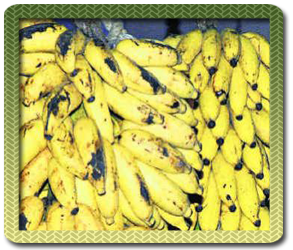 |
Special Features
-
The area of cultivation of Nanjangud rasabale, a special variety of banana only in and around Nanjangud areas of Karnataka.
-
The Nanjangud rasabale, which has unique characteristics, is identified by its distinct aroma when it ripens fully. The fruit is also characterised by its medium size and gall formation in the pulp. A major characteristic of the fruit is its long shelf life, as it survives for around a fortnight after its starts ripening.
-
It is more vulnerable to panama wilt, a soil-borne disease, than other plantain varieties such as yelakki and pacchbale (chikkibale).
Chandra Bale
Special Features
-
It is otherwise called as ‘Red Banana’
-
It is characterized by uniformly purple red pigmented pseudostem, leaf pedicel and bunch peduncle.
-
Plant is robust, tall variety.
-
Basically a shy yielder but has the potential to yield 30-40 kg bunches under favourable conditions.
-
It is highly susceptible to banana bunchy top virus, nematodes and wilt.
Marabale
Special Features
-
It is also called as hill banana.
-
It is a tall, strong and sturdy plant.
-
Fruits are angular, thick skinned and are loosely arranged on the female axis.
-
Fruits turn yellowish green upon ripening with cream coloured pulp having
distinctive flavor. -
It is well suited as a shade plant for young coffee plantation.
-
It is threatened by banana bunchy top virus aggravated by perennial system of
cultivation of hill banana.
Ney Poovan
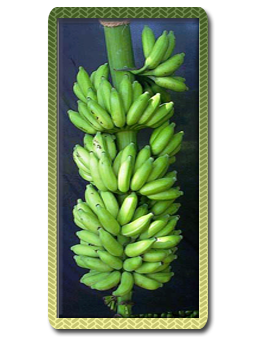 |
Special Features
-
Ney poovan is the unique diploid assuming commercial monoclonal cultivation on a large scale especially in Karnataka.
-
It is a slender , medium tall plant and bears bunch weight of 10-15 kg.
-
Fruits are smaller, slender with a prominent beak, are packed closely round the axis having a wind blown appearance.
-
Unripe fruits turn bright yellow upon ripening, pulp is ivory white in colour.
-
It is known for its good keeping quality and non detaching nature of fruit from the bunch making it suitable for long transportation.
-
It is tolerant to leaf spot disease but susceptible to Fusarium wilt, nematodes banana bract mosaic virus.
Kerala
Culinary Varieties
Nendran
 |
Special Features
-
Fruits have a distinct neck with thick green skin turning buff yellow on ripening.
-
Fruits remain as starchy even on ripening.
Remarks
Highly susceptible to Banana Bract Mosaic Virus (BBMV), nematodes and
borers.
Desert Varieties
Palayam kodan
 |
Special Features
-
This is the most widely cultivated variety of banana in Kerala, very soft when fully ripe.
-
It has a cooling effect on places of very hot and humid conditions.
Red Banana/ Kappavazha
 |
Special Features
-
It is known as’Kappa Vazha’ or chenkadali in Kerala.
-
Kappa pazham is the reddish variety more costlier than the other ones.
-
It is characterized by its red skin.
-
Fairly large sized fruit turns its color from deep brown to dark red as it ripens.
-
The edible part is very soft.
Rasthali
 |
Special Features
-
It is a medium tall variety and the Fruit is very tasty with a good aroma.
-
Its unique fruit quality has made Rasthali popular and a highly prized cultivar for table purpose.
-
It is easily identified by the yellowish green stem with brownish blotches reddish margin of the petiole and leaf sheath and a few persistent male flowers after the female flower phase.
-
Bunch has five to seven hands and the Fruits are yellowish green throughout their development, but turn pale yellow to golden yellow after ripening.
Remarks
-
Longer crop duration, severe susceptibility to fusarium wilt.
-
Requirement of bunch cover to protect fruits from sun cracking.
-
Formation of hard lumps in fruits make crop production more expensive.
Monthan
 |
Special Features
-
Fruits are bold, stocky, knobbed and pale green in colour.
-
The skin is usually green.
-
Pseudostem core is a highly relished vegetable with various medicinal properties.
-
Also cultivated for production of leaves.
Remarks
-
Immune to Banana Bunchy Top Virus (BBTV) diseases, salt tolerance and normal bunch mass even under marginal condition.
-
Highly susceptible to Fusarium wilt disease.
Nendran/ Ethakka
 |
Special Features
-
Fruits have a distinct neck with thick green skin turning buff yellow on ripening.
-
Fruits remain as starchy even on ripening.
Remarks
Highly susceptible to Banana Bract Mosaic Virus (BBMV), nematodes and borers.
Safed Velchi
 |
Special Features
-
Mostly grown as intercrop in coconut and arecanut garden.
-
The plants are medium-sized with slender, yellowish pseudostem having reddish petiole margin.
-
The fruits are small, firm-fleshed and sweet.
Robusta
 |
Special Features
-
It is also known as ‘Morris’.
-
It is cultivated throughout Kerala.
-
The banana that retains its green color even after ripening, it comes from a dwarf variety of banana plants.
Dwarf Cavendish/Morris
 |
Special Features
-
The plant stature is dwarf, making it less prone to wind damage.
-
The bunch size, fruit length and size is quite good though the keeping quality is rather poor.
-
Bunch has 6 - 7 hands.
-
The thick rind of the fruits retains greenish colour to some extent and even when the fruits are ripe.
-
Performs well under light soils with high inputs.
-
In combination with high-density planting and drip irrigation,Dwarf Cavendish is becoming a highly successful cultivar.
Remarks
It is highly susceptible to Sigatoka leaf spot disease in humid tropics restricting its commercial cultivation.
Karpooravalli
 |
Special Features
-
Karpuravalli is a tall, robust plant well suited to marginal lands and soils produced under low input conditions.
-
Karpuravalli is occasionally seeded depending upon the seasonal variability.
-
Its ash coated golden yellow and sweet fruits have good keeping quality.
Remarks
Karpuravalli is highly susceptible to wilt disease, tolerant to leaf spot disease and well suited for drought and salt affected areas.
Kathali
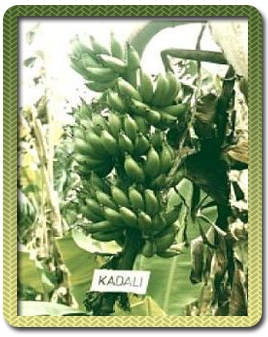 |
Special Features
-
Many varieties of Kathali are grown in Kerala.
-
This is also very tasty and small sized fruit.
-
Normally one bunch of fruit with 5-8 clusters, maximum of 85 fruits, weighing 7 - 9 kg.
-
It is generally used as dessert and as an offering to Gods in Hindu Temples. It also have medicinal usage.
Njalipoovan
 |
Special Features
-
Njalipoovan is a popular shade‐loving tolerant variety that has a great demand among consumers due to its superior fruit quality and it is a delicious variety.
-
It is more costlier than palayan kodan. Fruits are used more than the raw ones.
-
The fruits are very sweet and soft with thin peel. But poor keeping quality and the fruits fall off bunches.
-
It is particularly suitable for intercropping in coconut gardens both under rainfed and irrigated conditions.
-
It is less susceptible to most of the pests and diseases and adapted to rainfed cultivation with ratooning.
Kunnan
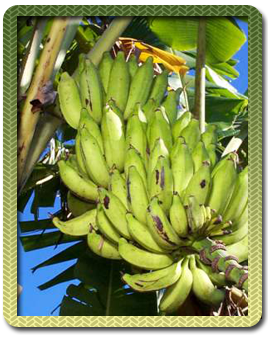 |
Special Features
-
It is a very common variety grown in Kerala.
-
This is a dual purpose variety.
-
Duration is about 16 months.
-
Keeping quality is good.
-
The fruits are used as Dessert and for making powder for infants as supplementary food.
-
Each bunch of fruit has 7-9 hands weighing 11-17 lbs.
Ayrinka Poovan
 |
Special Features
-
An unstable bud variant of Rasthali.
-
Varies from Rasthali only in that there are no male flowers so that the whole axis is covered with fruits.
-
The fruits of the first 5 to 6 hands are same as those of Rasthali, while the rest differ only in size.
-
Bunch 500 fruits, 25 kg.
-
Crop duration 15 months.
